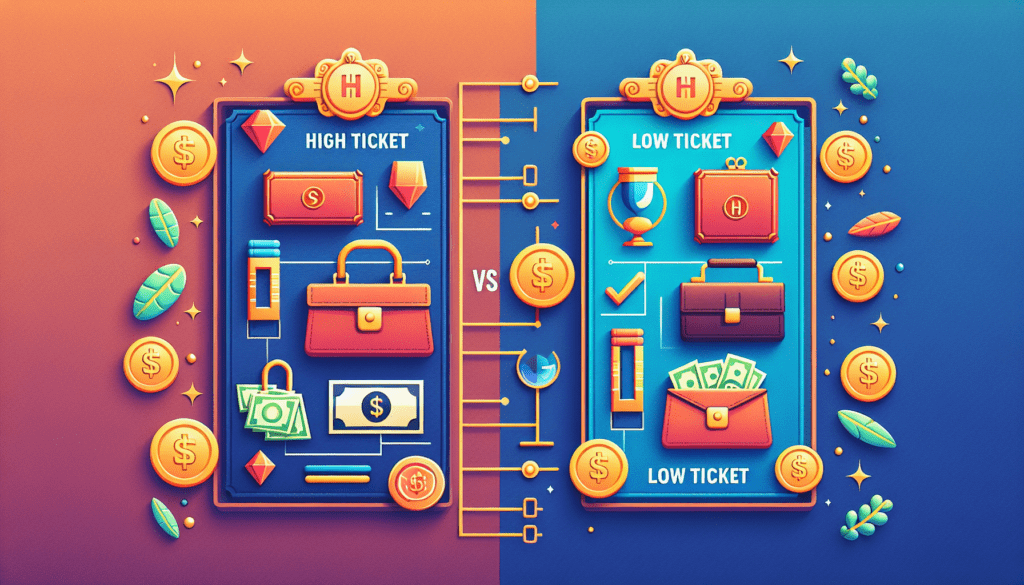
Introduction
Affiliate marketing is a powerful pathway to generate passive income, enabling individuals to earn commissions by promoting other people’s or company’s products. Yet, within this broad field, two distinct models exist: high-ticket and low-ticket affiliate marketing. Both offer unique advantages and challenges and choosing the right model can significantly impact your online business’s success. This article will delve into these two strategies, helping you navigate which path might best align with your marketing goals and expected returns. By understanding the key differences, you can tailor your approach and maximize your profit potential in the competitive world of affiliate marketing.
High Ticket vs Low Ticket Affiliate Marketing

Definition and explanation of high-ticket affiliate marketing
High-ticket affiliate marketing involves promoting products or services that are sold at a relatively high price. Generally speaking, these products command prices in the range of hundreds to several thousands of dollars. The commission rates for high-ticket items are usually substantial, often between 30% and 50%. Affiliate marketing is attractive because promoting and selling fewer high-cost items can generate significant earnings. High-ticket items include luxury goods, specialized software, high-end electronics, and advanced educational courses.
Definition and explanation of low-ticket affiliate marketing
On the other end of the spectrum, low-ticket affiliate marketing focuses on relatively inexpensive products or services—typically under $100. These items often require minimal deliberation from the buyer, leading to impulse purchases. The commissions for low-ticket items are lower than those for high-ticket items, usually around 5% to 15%. Examples of low-ticket products include books, small household gadgets, beauty products, and affordable software apps.
Pros and cons of high-ticket affiliate marketing
Pros:
- Higher Commissions: Selling a high-ticket item can generate the same commission as selling multiple low-ticket items, making it financially appealing.
- Lower Traffic Requirements: Because each sale generates a higher profit, affiliates don’t need to drive immense traffic volumes to achieve a substantial income.
- Enhanced Customer Support: Higher-priced products often come with better customer service, which can aid in maintaining customer satisfaction and ease the marketing process.
Cons:
- Higher Customer Expectations: Customers spending large amounts of money have proportionally higher expectations, which can pressure affiliates to deliver exceptional quality.
- Longer Sales Cycle: The decision-making process for high-ticket purchases is usually longer, requiring more effort in nurturing leads.
- Limited Audience: The market for expensive products is naturally smaller, which can be a significant hurdle in finding potential buyers.
Pros and cons of low-ticket affiliate marketing
Pros:
- Broader Market Appeal: Low-cost items appeal to a larger audience, which can lead to more frequent sales.
- Faster Sales Cycle: The buying decision for low-cost items is quicker, which can lead to faster commissions.
- Great for Beginners: Low-ticket affiliate marketing is ideal for beginners, as it involves less risk and simpler sales processes.
Cons:
- Lower Profit Margins: Affiliates must sell a large volume of products to generate substantial income, which can be labor-intensive.
- High Competition: Many affiliates promote low-ticket items due to the low entry barrier, increasing competition.
- Continuous Marketing Effort Required: Constant promotion is necessary to maintain income levels, as individual earnings per sale are low.
Factors to Consider
Target audience and niche suitability
Every niche has a unique audience, and understanding this is crucial in choosing between high-ticket and low-ticket affiliate marketing. High-ticket items often cater to more specialized, affluent, or professional groups who value these products’ specific benefits and exclusivities. On the contrary, low-ticket items generally aim at a broader audience, focusing on everyday needs and convenience. Identifying and understanding your target audience’s needs, preferences, and purchasing power can significantly impact your affiliate strategy’s effectiveness.
Marketing strategy and effort required
The required marketing strategy varies greatly between high-ticket and low-ticket products. For high-ticket items, a more personalized, trust-based approach is necessary. This might include detailed content marketing, webinars, and direct interactions. Low-ticket affiliate marketing, however, benefits from volume-based strategies such as SEO, PPC campaigns, and social media advertising to quickly catch the buyer’s attention. The effort required in either approach should align with your marketing skills and resources to ensure sustainability and growth.
Revenue potential and profit margins
Potential revenue and profit margins are critically important in determining which type of affiliate marketing to pursue. High-ticket affiliate marketing can yield high returns per sale but requires persistence and sophisticated selling skills to convert the audience into buyers. In contrast, low-ticket items offer smaller margins but can compensate with volume sales. This requires constant engagement and marketing efforts to keep a stream of transactions. Balancing between the two based on desired income goals and operational capacity is key to a successful affiliate marketing strategy.
Tips for Choosing the Right Strategy

Evaluating your goals and resources
To select between high-ticket and low-ticket affiliate marketing, start by assessing your goals and the resources available. Consider these factors:
- Initial capital: High-ticket items often require an upfront investment for paid campaigns and professional content creation, while low-ticket items can frequently be promoted effectively with less initial spending.
- Time investment: High ticket affiliate marketing demands more in-depth content and personalized follow-up, which is suitable for those who can dedicate more time and patience to see larger, less frequent sales. In contrast, low ticket marketing might be more appealing if you seek quicker returns and have less time for customer engagement.
- Expected ROI: High ticket items usually bring higher commissions per sale but might involve a longer sales cycle. Evaluate whether the potential return justifies your effort and investment.
Understanding your audience’s purchasing behavior
Analyzing how your audience makes purchasing decisions is critical in tailoring your affiliate marketing strategy:
- Buying power: High-ticket products suit audiences with a greater disposable income or businesses looking for substantial solutions, while low-ticket products better suit budget-conscious individuals.
- Purchase frequency: Low ticket items offer the advantage of frequent purchases, which can lead to regular commissions. Focusing on low-ticket items might be more productive if your audience prefers incremental buying.
- Customer journey: Reflect on the complexity of the customer journey associated with your products. High-ticket items often involve a longer decision-making process, necessitating extensive nurturing strategies.
Analyzing market trends and competition
Finally, keeping an eye on the market trends and competitive landscape can guide you in choosing an effective affiliate strategy:
- Market demand: Research the current trends for high-ticket and low-ticket items. High demand in either category might offer lucrative opportunities.
- Competition analysis: Investigate the level of competition in your chosen niche. A highly competitive market may require unique strategies to stand out, potentially influencing your choice between high and low-ticket products.
- Adaptability: Consider how flexible different affiliate models are to changes in market conditions. High-ticket items might be more sensitive to economic downturns, whereas low-ticket items could be less affected.
In conclusion, your choice between high ticket and low for affiliate marketing should align closely with your personal goals, resources, audience understanding, and an insightful interpretation of market dynamics.
Conclusion
Whether you choose high-ticket or low-ticket affiliate marketing depends largely on your target audience, marketing skills, and investment capacity. High-ticket items can yield substantial commissions per sale but generally require more persuasion and trust-building, making them suitable for marketers with well-established platforms and high expertise. On the other hand, low-ticket items offer quicker, more frequent sales with less risk, which is ideal for beginners or those looking to create a volume-based revenue model.
For the best results, consider your strengths and preferences, the nature of your audience, and the specific demands of your market niche. By aligning your affiliate marketing strategy with these factors, you can maximize your effectiveness and profitability in the competitive online business landscape. Remember, success in affiliate marketing comes from continuous learning, adapting, and persistent effort.